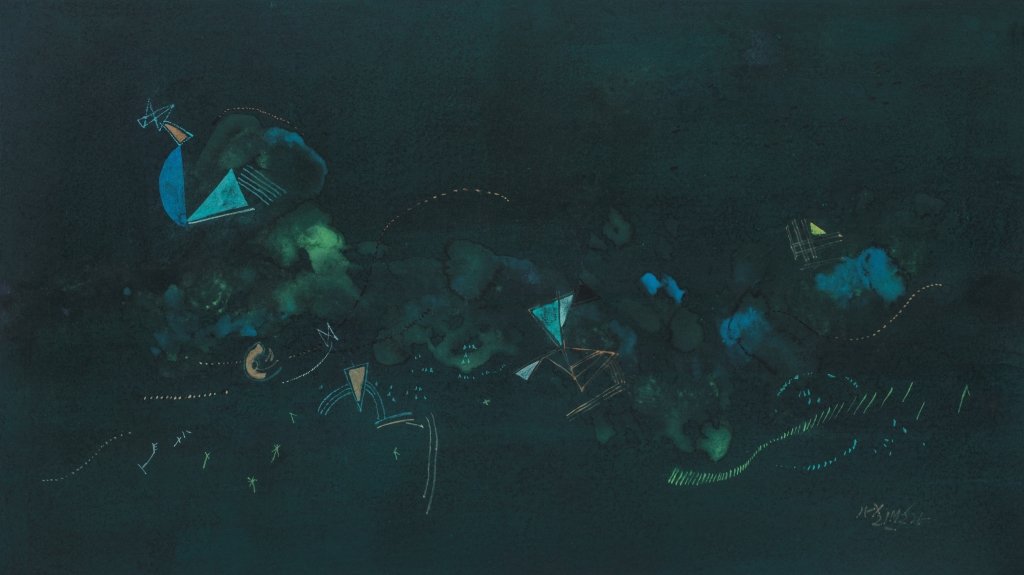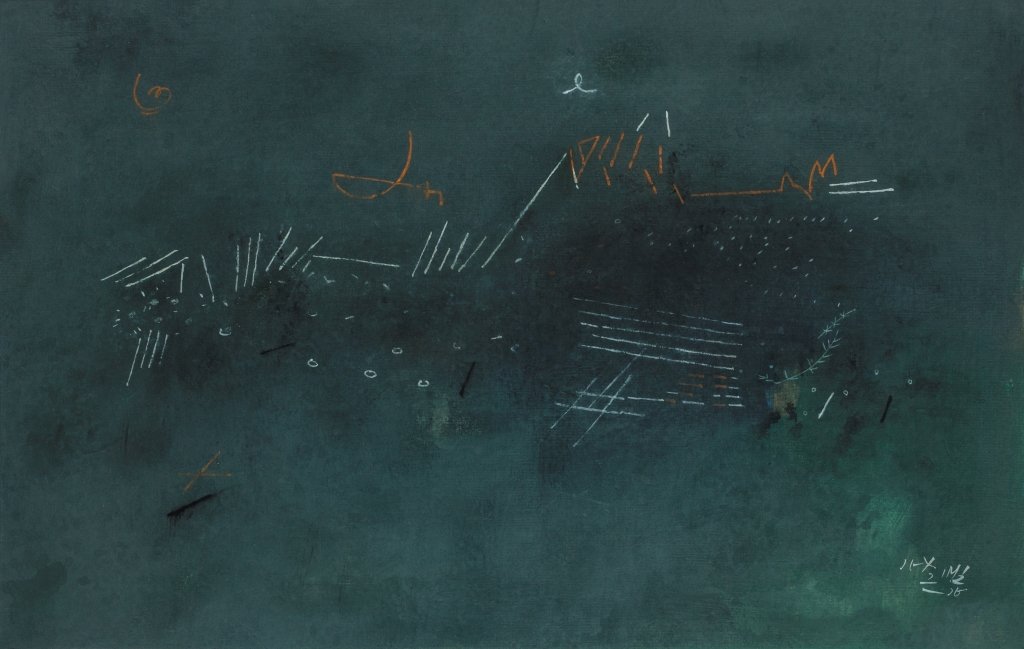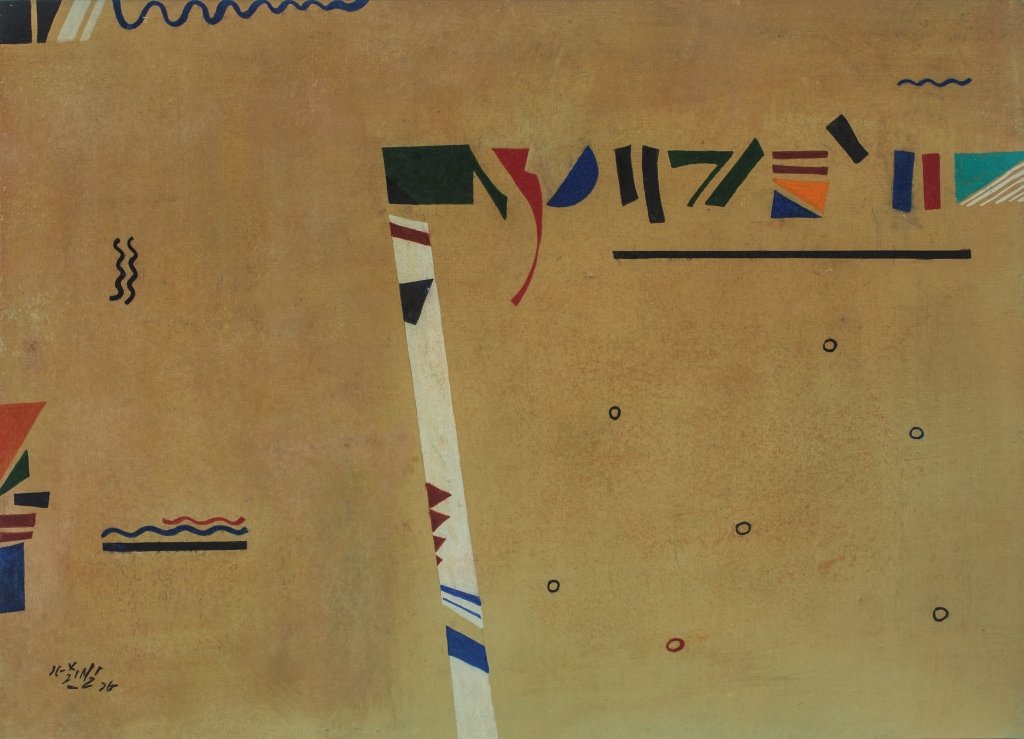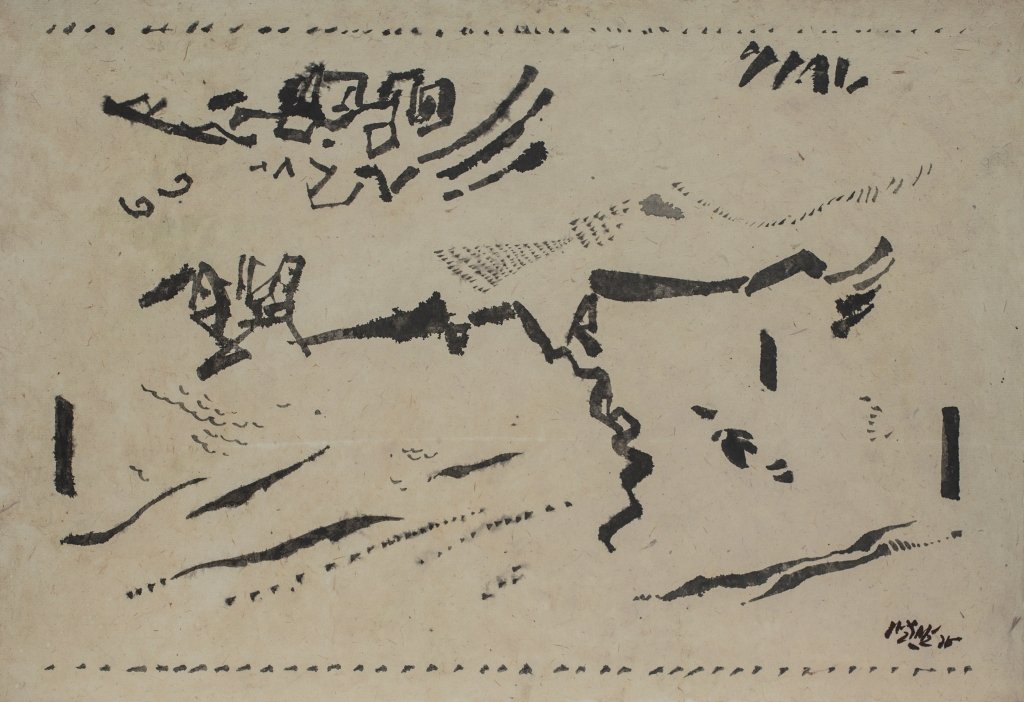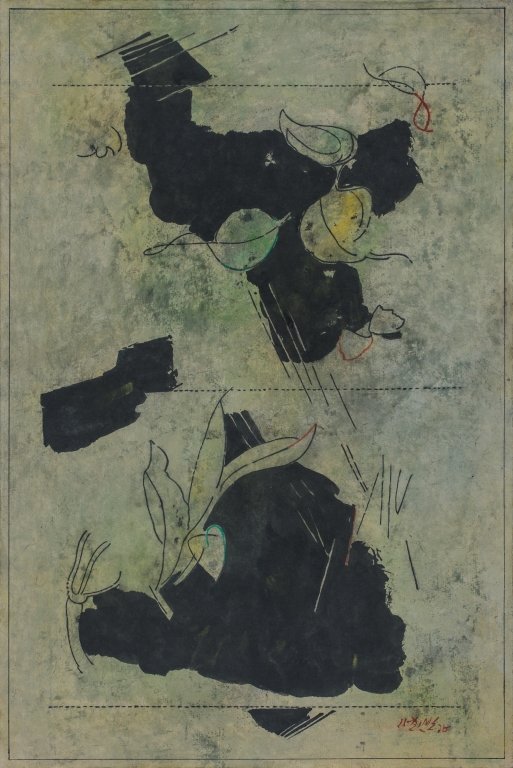
Form & Play by Ganesh Haloi
January 18 – February 11, 2019 at Akar Prakar, Kolkata
‘You cannot imagine how much freedom I enjoy. And because I feel that sense of infinite freedom I can exercise that to create my own land. It is my own world – parallel to and different from what you call reality.’
Beyond these intimate moments of creation and personal engagement Ganesh Haloi occupies a significant place in the history of post-independence modern Indian art. Historically speaking, he happened to have chosen an artistic trajectory that is exceptional not only because of his stylistic innovations but also in terms of concerns and content. His art characteristically makes him a sort of loner yet he is very much a part of the history that has encouraged the artists to eschew preset agendas and embrace subjectivity. Bengal artists of the post-independence era, who moved beyond the traditionalist-modernist binary and negotiated the cross-currents with contemporary concerns rather than ideological choices, were by and large figurative artists with various degrees of representational indexes. Ganesh Haloi is one exception who despite his initial figurative works gradually drifted towards non-figurative images and eventually became one of the most sought-after abstract painters from his generation. His paintings are about the compelling world of nature as much as they are about the autonomy of image making. From broad colour fields to minuscule dots and calligraphic lines – the entire range of visual vocabulary in Haloi’s works is played out in a way that on the one hand they function as pictorial signs and on the other as evocative marks. This ambivalence empowers Haloi to explore the possible nuances both at the experiential and metaphoric level. Interestingly, Haloi owes his tonal understanding to his painstaking study of traditional Indian murals at Ajanta. The refinement of his art and the subdued appeal of his paintings can also be attributed to the reticent character of traditional painting although he gives them a modernist turn by accentuating its formal edge and pairing down the image to bare essentials, stripping the composition off the narrative substance. What he is left with, as far his association with traditional Indian painting is concerned and as it is conspicuously visible in his drawings and paintings, is essentially the joy and pleasure of visual composition integrally woven into his deep sense of pathos and melancholy as well. Both the transient and the eternal have been turned into magnificent visual metaphors and unique graphic insignias.
His evocative abstractions in semi-opaque and translucent colours encode an elegy of lost landscape, a nostalgic poetry, and a mapping of the poignant past either radiating a bliss or frozen into a pensive mood. Unlike Kandinsky who deliberately courted obscurity as part of his visual language Haloi’s art is extraordinarily lucid and coherent. The transcendental quality one feels in Haloi’s works is embedded in the very perceptual logic and pictorial making of his paintings. The viewer is enchanted by the sheer dexterity acquired by the artist over the decades involving meticulous research and practice on the techniques and methods of gouache and paintings. Though his paintings follow a reductionist, non-mimetic and often symbolic idiom they essentially embody a poetic and lyrical vision – poised between the seen and the sensed.
As one gradually engages with his paintings one is inclined to feel that the abstract in his works exists more as a tendency, as a linguistic strategy and certainly not as an aim, not as a final realization. It is therefore not surprising that Haloi is never willing to attach the term abstract to his works either as a stylistic category or as an aesthetic nomenclature.
‘I can sense, feel and even see everything out there and in my works. Not only the tangible physical world and its nurturing forces but I can also see the elusive atmospheric elements – the ethereal ones like the wind, air, light, darkness, sound, resonance, silence, movement, vibration, rhythm everything. You can find all these elements in my works.’
Soumik Nandy Majumdar, Professor of Art History, Vishva Bharati University, Santiniketan
Ganesh Haloi | Untitled | Gouache on Nepali handmade paper | 12.75 x 29.5 in | 2018
Ganesh Haloi | Untitled | Gouache on Nepali handmade paper | 9 x 19.75 in | 2018
Ganesh Haloi | Untitled | Gouache on Nepali handmade paper | 16.5 x 29.75 in | 2018
Ganesh Haloi | Untitled | Gouache on Nepali handmade paper | 17.5 x 19.5 in | 2018
Ganesh Haloi | Untitled | Gouache on Nepali handmade paper | 18 x 27.5 in | 2018
Ganesh Haloi | Untitled | Gouache on Nepali handmade paper | 18 x 27.75 in | 2018
Ganesh Haloi | Untitled | Gouache on Nepali handmade paper | 18 x 27.75 in | 2018
Ganesh Haloi | Untitled | Gouache on Nepali handmade paper | 18.5 x 25.5 in | 2018
Ganesh Haloi | Untitled | Gouache on Nepali handmade paper | 18.5 x 25.75 in | 2018
Ganesh Haloi | Untitled | Gouache on Nepali handmade paper | 18.5 x 27.75 in | 2018
Ganesh Haloi | Untitled | Gouache on Nepali handmade paper | 18.5 x 28.25 in | 2018
Ganesh Haloi | Untitled | Gouache on Nepali handmade paper | 18.5 x 28.75 in | 2018
Ganesh Haloi | Untitled | Gouache on Nepali handmade paper | 18.5 x 31.25 in | 2018
Ganesh Haloi | Untitled | Gouache on Nepali handmade paper | 18.5 x 32.5 in | 2018
Ganesh Haloi | Untitled | Gouache on Nepali handmade paper | 18.5 x 32.5 in | 2018
Ganesh Haloi | Untitled | Gouache on Nepali handmade paper | 19.5 x 28.75 in | 2018
Ganesh Haloi | Untitled | Gouache on Nepali handmade paper | 19.5 x 30 in | 2018
Ganesh Haloi | Untitled | Gouache on Nepali handmade paper | 19.5 x 30 in | 2018
Ganesh Haloi | Untitled | Gouache on Nepali handmade paper | 19.25 x 30 in | 2018
Ganesh Haloi | Untitled | Gouache on Nepali handmade paper | 19.5 x 30 in | 2018
Ganesh Haloi | Untitled | Gouache on Nepali handmade paper | 19.75 x 20.75 in | 2018
Ganesh Haloi | Untitled | Gouache on Nepali handmade paper | 19.75 x 23.5 in | 2018
Ganesh Haloi | Untitled | Gouache on Nepali handmade paper | 19.75 x 29.5 in | 2018
Ganesh Haloi | Untitled | Gouache on Nepali handmade paper | 19.75 x 29.25 in | 2018
Ganesh Haloi | Untitled | Gouache on Nepali handmade paper | 26.25 x 18.5 in | 2018
Ganesh Haloi | Untitled | Gouache on Nepali handmade paper | 29.75 x 19.75 in | 2018
Ganesh Haloi | Untitled | Gouache on Nepali handmade paper | 30 x 19.75 in | 2018
About Ganesh Haloi
Ganesh Haloi was born in 1936 in Jamalpur, Mymensingh (in present-day Bangladesh). He moved to Calcutta in 1950 following the partition. The trauma of displacement left its mark on his work as it did on some other painters of his generation. Since then his art has exhibited an innate lyricism coupled with a sense of nostalgia for a lost world. In 1956, he graduated from the Government College of Art and Craft, Calcutta. In the next year, he was appointed by the Archaeological Survey of India to make copies of Ajanta murals. Seven years later, Haloi returned to Calcutta. From 1963 until his retirement, he taught at the Government College of Art and Craft. He is a Member of The Society of Contemporary Artists, Calcutta since 1971, and lives and works in Calcutta.
He has participated in several group exhibitions in India, Greece/Germany (Documenta 14 at Athens & Kassel), California (Architecture of Life, at Berkeley Art Museum & Pacific Film Archives (BAM/PFA), Berkeley), Berlin (8th Berlin Biennale for Contemporary Art), London (A Special Arrow Was Shot in the Neck, David Roberts Art Foundation). He is represented by Akar Prakar Kolkata and New Delhi, and has had various solo exhibitions in Kolkata, Delhi, Mumbai, Dhaka and New York including Sense & Sensation at Akar Prakar Kolkata and New Delhi in 2021, Form & Play at Asia Week New York in 2020 to name a few.





